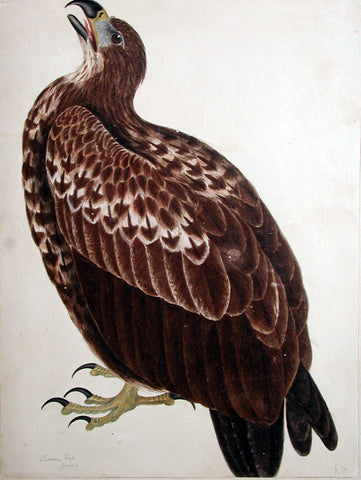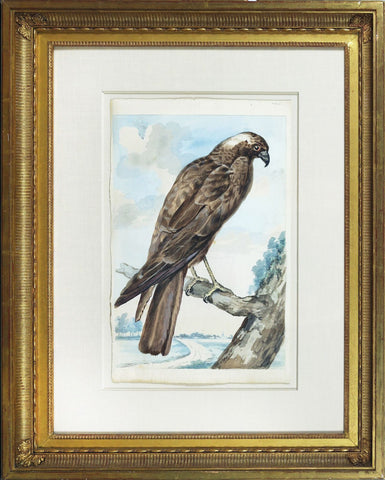
Robert Mitford (British, 1781-1870), “Cinereous and Sea Eagle, Young”
Robert Mitford (British, 1781-1870)
“Cinereous and Sea Eagle, Young”
Original watercolor prepared for Plate 3a of Illustrations of British Ornithology
Watercolor, gouache, pen and ink on paper
Signed ‘R. M’ l.r. and inscribed ‘Cinereous Eagle, Young; l.l.
Paper size: 21 7/16 x 15 1/4 in.
London, ca. 1820
Provenance: Library of H Bradley Martin.
Selby’s text for the Cinereous and Sea Eagle, Young is as follows:
“This genus, of which our Sea-Eagle (Falco albicilla, Auct.) supplies an example, differs from the Ospreys or true fishing Eagles (genus Pandion, Savig.) in the form of the bill, and in the claws being grooved, and not rounded beneath; with that upon the inner toe being much larger and stronger than that of the outer, the contrary of which characterizes the genus Pandion. The plumage is also different in texture, being looser, and resembling that of the typical Eagles, and the thighs, instead of a covering of short and thick set feathers, are furnished with long plumes, a circumstance which indicates a difference of economy. The habits of this genus are less predatory, and their boldness is not so great as in the members of the genus Aquila, added to which, their aspect altogether approaches nearer to that of the Vultures.
The identity of the Cinereous and Sea Eagle is now so satisfactorily established, that I have, without any hesitation, brought the synonyms hitherto assigned to the two supposed species under the same head. To many, it may appear singular that this fact should only now be fully ascertained; but when we consider the great impediments to the investigation of the natural history of these birds, arising from the wild and mountainous districts they inhabit, the difficulty of procuring specimens, and the few opportunities afforded, therefore, of watching the progress of the young bird to maturity; the slow advance of our knowledge in regard to this, as well as other facts connected with this branch of science, will rather be a matter of regret than surprise. Many of our ornithological works, also, can only be regarded as compilations from the essays of earlier authors, in which the errors, arising from such deficiency of information as must naturally attend the infancy of a new pursuit, may be expected; and which errors have too often, without any attempt at further scrutiny, been faithfully transcribed.
The similarity in habits and manners, as well as in essential specific characters, between the Cinereous and Sea Eagle, first led me to suppose that they were ‘of the same species, and that the difference of plumage might only provided from the respective ages of the individuals, as appears in many other instances. An opportunity having occurred of watching the progress of the young Sea Eagle from its
earliest age, I eagerly availed myself of it, and witnessed the gradual and interesting changes it underwent, till it had finally acquired the plumage of the adult or Cinereous Eagle.
During this process, I was happy to find, that my supposition had been anticipated, and the fact ascertained in France, by that eminent naturalist Mons. Cuvier, as well as by Mons. Temminck.
The Cinereous Eagle is more numerous than the preceding species, and is found in all the northern and mountainous maritime districts of Scotland and Ireland, and in the Orkney and Shetland Isles. It is also of a more roving disposition, and has frequently been killed in England.
Montague mentions several instances, and adds, that scarcely a year passes without some of these birds being seen in the New Forest in Hampshire. In Northumberland, the Cinereous Eagle has frequently been seen during the winter months. About six years ago, a fine specimen was killed at Chillingham Park, the seat of the Earl of Tankerville; and two more in the winter of the following year, and both of these were in the state indicating immaturity. They appear to have resorted to this place from a facility of obtaining food, which the weak and fallen deer in a hard season liberally present.
In February 1828, two eagles of this species were killed upon the Northumbrian Coast; one near to Scremmerstone, and now in the possession of Robert Wilke, Esq. of Lady thorn; the other at Holy Island, and now in my collection, having been kindly presented to me by John Donaldson, Esq. of Cheswick. They were both immature birds, apparently about two years and a half old, having undergone two moultings. The bird presented to me proved to be a female; the sex of the other was not ascertained. It is probable, from being both of the same age, and killed within a few miles of each other, that they had belonged to the same eyry, and had continued associated from the time of quitting the nest.
In their native districts, they are generally seen near the sea- shores, or the precipices skirting the margins of inland lakes, as their favourite food consists of fish, which they pounce upon whilst swimming near the surface of the water; or which they compel the Ospreys, after having captured them, to yield to their superior strength. Aquatic birds also become a frequent prey, as well as fawns and roe-bucks. They generally breed in the most inaccessible cliffs, and lay but one, or at most two eggs, entirely, white, and nearly the size of those of a goose. In my collection, is an egg laid by a bird of this species, after having been kept in a state of confinement for upwards of twenty years. The Cinereous Eagle possesses astonishing capability of enduring the cravings of hunger ; and instances are on record where it has shewn undiminished vigour, after fasting for four or five weeks. I am acquainted with an instance, in which the bird was permitted, through the inattention of its keeper, to be without food for several weeks, till its sufferings were so severe as to excite it to gnaw the flesh from the pinions of its own wings. In defect of living prey, this species readily feeds upon the dead carcasses of sheep and other animals, and is frequently caught in Scotland by the following device: “A miniature-house, at least the wall part of it, is built on ground frequented by the eagle, and an opening left at the foot of the wall, sufficient for the egress of the bird. To the outside of this opening a bit of strong skeiny (cord) is fixed, with a noose formed on one end, and the other running through the noose. After all this operation is finished, a piece of carrion is thrown into the house, which the eagle finds out, and perches upon. It eats voraciously, and when fully satisfied it never thinks of taking its flight immediately upwards, unless disturbed, provided it can find any easier way to get out of the house ; for it appears that it cannot readily begin its flight, but in an oblique direction; consequently it walks deliberately out at the opening left for it, and the skeiny being fitly contrived, and placed for the purpose, catches hold of and fairly strangles it.” This bird is of powerful form, but not so compact as the Golden Eagle.
Its aspect is also heavier, and it has not the same alertness and activity. When reposing, it sits with drooping wings, and the feathers of the body ruffled in the manner of the Vultures, with which birds, indeed, it was at first classed by Linnus; a proof of the striking affinity it bears to that family. It is of wide distribution, species being found in all quarters of the globe.
Young Plate 3a. Represents the young of this species after the second moult, or in that state in which it has been named the Sea Eagle (Falco ossifragus of authors).
Bill bluish-black, paler towards the base. Cere wax-yellow. Irides pale chesnut-brown. Head and neck dark- brown, the tips of the feathers rather paler, the roots white. Upper parts reddish-brown, the feathers paler towards the base, and having the whole of their shafts dark. Under parts brown, of different shades, inter-mixed with a few white feathers. Quills brownish-black. Tail marbled with shades of hair and clove-brown, and darkest towards the end .”
Prideaux John Selby (British, 1788-1867)
Considered by many as the English equivalent of Audubon, Prideaux John Selby created some of the most memorable bird images of the nineteenth-century. His contributions to British ornithology were rivaled only by those of John Gould. Yet, his pictures were larger and less purely scientific, exhibiting Selby’s distinctive and charming style. A sense of Selby’s enthusiasm for his subjects is nowhere more palpable than in his engaging original watercolors. Selby executed these delightful images as preparatory models for his landmark printed series, Illustrations of British Ornithology. While the artist’s engraved work is highly desirable to collectors, Selby’s original watercolors rarely become available. This selection of watercolors, moreover, comprises several of his masterpieces. The distinctive birds are depicted in profile, their forms delineated by softly modulated tones of black and gray wash. The setting, if present, is lightly but skillfully painted to not distract from the birds themselves. The skill and delicacy of Selby’s touch, his keen powers of observation, and his artistic sensitivity are conveyed here in a way they are not in his printed work. Several of the drawings are by Selby’s brother-in-law, Robert Mitford, but signed in Selby’s hand.
Born in Northumberland and educated at University College, Oxford, Selby was a landowner and squire with ample time to devote to studying the plant and animal life at his country estate, Twizell House. As a boy, he had studied the habits of local birds, drawn them, and learned how to preserve and set up specimens. Later, Selby became an active member of several British natural history societies and contributed many articles to their journals. Although Selby was interested in botany and produced a History of British Trees in 1842, he is best known for his Illustrations of British Ornithology. Selby’s work was the first attempt to create a set of life-sized illustrations of British birds, remarkable for their naturalism and the delicacy of their execution. The British Ornithology was issued in nineteen parts over thirteen years; the book consisted of 89 plates of land birds and 129 plates of water birds, engraved by William Lizars of Edinburgh, the printer who engraved the first ten plates of Audubon’s Birds of America.
With their rich detail and tonal range, these exquisite watercolors are beautiful works by one of the foremost British bird painters. Furthermore, they represent a singular opportunity to obtain a unique piece of the highest quality by this luminary artist, from an era in British ornithological art that remains unparalleled.
Please feel free to contact us with questions by phone at 215.735.8811,
or by email at loricohen@aradergalleries.
We Also Recommend





